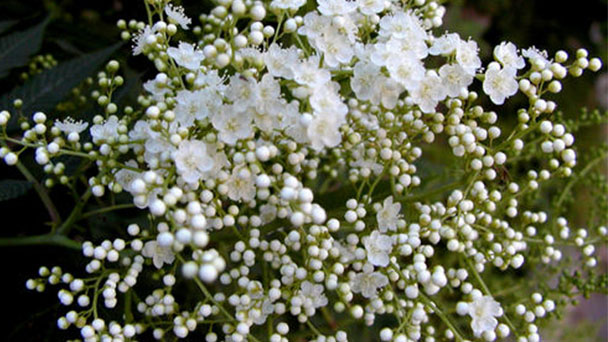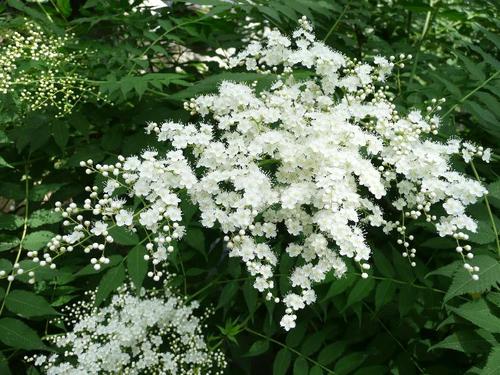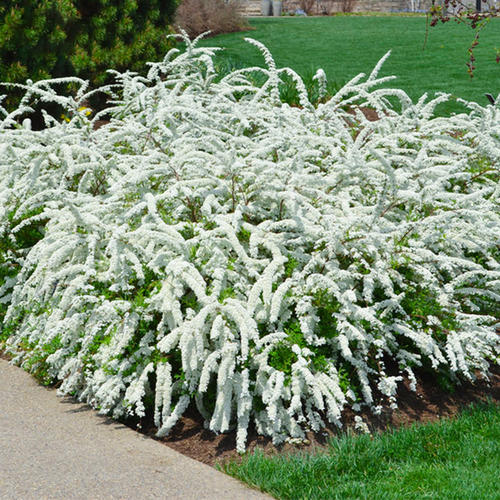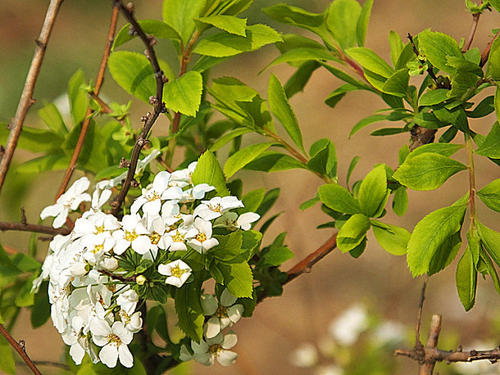Spiraea thunbergii profile
Written by Maggie
Nov 17 2020

Spiraea thunbergii is a Rosaceae. It is produced in eastern China and also distributed in Japan. It likes light, warm and moist soil, cold-resistant.
Spiraea thunbergii picture

Spiraea thunbergii morphological characteristics
Spiraea thunbergii is a deciduous shrub with a height of 1.5 meters. There are clusters of branches, the branches are slender and curved, and the branchlets are angular. Single leaf alternate, leaf lanceolate, apex acuminate, edge with blunt serrations, hairless on both sides, petiole short or nearly sessile. From March to April, the flowers and leaves are placed together. The flowers are white, small and dense, with slender pedicels and 3 to 5 umbels.
Spiraea thunbergii is a cluster of deciduous shrubs that can reach more than 2 meters in height. The branches are slender, open, and curved. The branchlets are brown when young, pubescent, and gray-brown when old, without hair, with peeling bark. The leaves are strip-lanceolate, 2.5~3 cm long, apex is long and acuminate, base is narrow and wedge-shaped. Leaf surface is glabrous, the petiole is short or nearly absent. The flowering period of spiraea thunbergii in Shanghai is mid to late March, and the flowering period in the north is about one month later. The umbrella is white, without a peduncle. It iss born in the middle and upper part of thin branches, forming a white, bright line. Flowering period is two weeks.
There are clusters of branches, the branches are slender and curved, and the branchlets are angular. Single leaf alternate, leaf lanceolate, apex acuminate, edge with blunt serrations, hairless on both sides, petiole short or nearly sessile. From March to April, the flowers and leaves are placed together. The flowers are white, small and dense, with slender pedicels and 3 to 5 umbels.
Spiraea thunbergii growth environment
Spiraea thunbergii loves sunlight and has strong tolerance to cold, humidity and drought. The soil is not strict, and it can grow normally in ordinary soil, but grows stronger in moist and fertile soil. Ordinary cultivation of gardens and green spaces and residential courtyards are in northern China. It grows faster, has a strong sprouting ability, and is resistant to pruning. The method of removing old branches can be used to alternate between the old and the new to continuously renew and rejuvenate. In the growing season, if you do not pick seeds, you should cut off the remaining flowering branches at any time after flowering to maintain a perfect posture.

Spiraea thunbergii distribution range
Spiraea thunbergii is native to China and Japan, and is mainly distributed in Zhejiang, Jiangxi, Yunnan and other provinces in China. It is distributed in Hebei, Shanxi, Shandong, Henan, Shaanxi, Gansu, and Inner Mongolia.
Spiraea thunbergii main value
Garden
Spiraea thunbergii is often planted as a single plant in gardens and yards. Generally, it is not necessary to fertilize, but it must be irrigated frequently, especially during dry seasons in spring and summer to keep the soil moist. Pour enough winter water before the beginning of winter, and protect overwintering in alpine areas, and other management are relatively extensive. Spiraea thunbergii is full of bushes, delicate branches and leaves, and elegant white flowers bloom in the midsummer when there is no flower, and the flowering period is very long. In particular, it can kill or inhibit a variety of harmful bacteria, and is suitable for planting in various garden green spaces. In particular, it has the characteristics of tolerance to shade, so it is a flowering shrub species for greening the shade on the north side of high-rise buildings and various buildings in northern cities.
Spiraea thunbergii can be planted in front of courtyard houses, roadsides, poolsides, or in clusters on lawns and around buildings for plastic planting. When the flowers bloom in spring, the jade flowers gather, like snow, very beautiful.

Latest Updated
- Benefits of Bugleweed - 7 Science-backed Health Benefits
- Bugleweed Dangers & Side Effects - Is It Poisonous?
- How to Plant Evergreen Trees - What You Should Know
- When to Plant Evergreens - Grow Guide for Evergreen Trees
- 12 Wonderful Evergreen Shrubs for Your Garden
- 12 Popular Evergreen Plants with Pictures for Beginners
- When And How To Prune A Lilac Bush Like a Pro
- How to Grow & Care for Lilac Vine (Hardenbergia Violacea)
- Japanese Lilac Tree (Syringa Reticulata) Care & Propagation Guide
- Shumard Oak Pros and Cons - What to Know
Popular Articles
- Winter maintenance of Antirrhinum Majus
- How to Grow Terminalia Mantaly Tree
- How to Grow and Care for Crossostephium Chinense
- How to grow Antirrhinum Majus in spring
- Peristeria Elata (Dove Orchid) Profile: Info & Care Guide
- Underwatered Snake Plant (Sansevieria Trifasciata) - Signs And How To Fix
- How to Care for Brazilian Jasmine Plant (Mandevilla Sanderi)
- How to Grow & Care for Graptopetalum Purple Delight in Summer
- Rosa Chinensis (China Rose): Plant Growing & Care Tips
- How to Care for Baby Sun Rose (Aptenia Cordifolia)